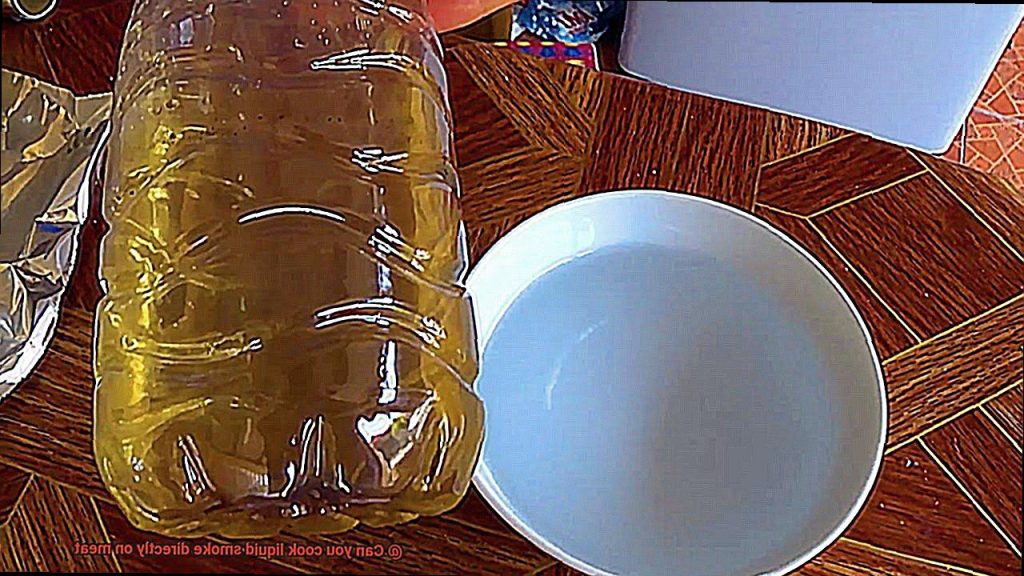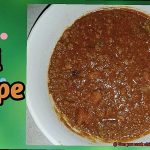Are you a meat lover who craves the smoky flavor but lacks the equipment to smoke or grill? Fear not, for liquid smoke is here to save the day. This magical ingredient has been around for over 100 years, capturing the essence of smoke in a bottle. By condensing smoke from burning wood chips and capturing the vapors in water, it produces a concentrated smoky flavor in liquid form that can be applied directly onto meat as a marinade, rub, or brushed on during cooking.
But wait, before you start pouring liquid smoke all over your meat like it’s going out of style, there are some things you should know. Using too much liquid smoke can overpower and ruin the taste of your dish. It’s best to start with a small amount and gradually increase it to reach your desired level of smokiness. Additionally, since liquid smoke is highly concentrated, using too much could lead to health issues.
In this post, we’ll explore everything you need to know about using liquid smoke on meat – from how to get started to its health benefits and risks. So let’s dive into the world of liquid smoke and elevate your meat game.
Contents
Can You Cook Liquid Smoke Directly on Meat?
As a fan of smoky flavors in your food, you may have heard of liquid smoke. It is a concentrated liquid flavoring made by burning wood chips and capturing the smoke in water, making it ideal for adding a smoky taste to a variety of dishes.
The good news is that you can cook liquid smoke directly on meat. However, there are some things to keep in mind to achieve the best results.
Firstly, it’s essential to use liquid smoke sparingly. It’s a potent ingredient that can quickly overpower your dish and result in an unpleasant taste. Start with just a few drops or a light brushing and adjust as needed.
Secondly, while liquid smoke can add a similar smoky flavor to meat, it’s not a substitute for traditional smoking methods. Traditional smoking methods like smoking meat over wood chips or charcoal provide more texture and depth of flavor that liquid smoke alone cannot deliver.
Lastly, it’s crucial to ensure that your meat is properly seasoned before applying liquid smoke. Liquid smoke alone will not add much flavor if the meat is bland or under-seasoned. Be sure to season the meat with salt, pepper, and any other desired spices before applying the liquid smoke.
There are different ways you can use liquid smoke on your meat. You can mix it with other ingredients like oil, vinegar, herbs, and spices to create a flavorful marinade. Coat the meat in the marinade and let it sit in the fridge for several hours or overnight to infuse the meat with a subtle smoky taste.
Liquid smoke can also be added to sauces or rubs. For example, try mixing it with BBQ sauce for a smoky flavor or sprinkling it on a dry rub before grilling or smoking meat.
The Dangers of Cooking Liquid Smoke Directly on Meat
Liquid smoke may seem like a convenient shortcut to achieving that smoky flavor, but beware of the potential dangers when using it directly on meat. Here’s what you need to know.
Firstly, cooking liquid smoke directly on meat poses a risk of forming polycyclic aromatic hydrocarbons (PAHs). PAHs are harmful chemicals that can cause cancer and other health problems. While the amount of PAHs that may form from using liquid smoke is likely to be lower than when cooking over an open flame, it’s still a risk to be aware of.
Another disadvantage of using liquid smoke directly on meat is that it can result in an artificial smoke flavor that may not be as appealing as the real thing. Using too much liquid smoke can also be overpowering and not provide the same nuanced flavors as natural wood smoke. Additionally, liquid smoke may not penetrate deep into the meat, leading to uneven flavor distribution.
So what are some alternatives? When possible, use natural wood smoke for a more authentic and flavorful experience. However, if you don’t have access to a smoker or grill, using liquid smoke sparingly in combination with other cooking methods can still provide some smoky flair.
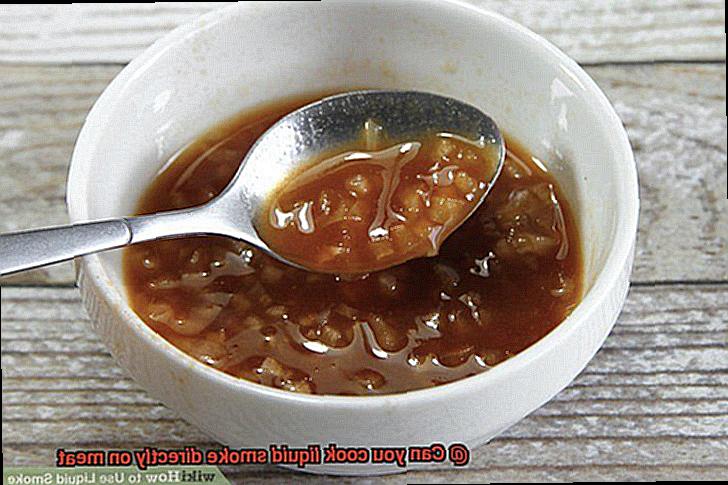
How to Use Liquid Smoke as a Marinade
Here are some tips on how to use liquid smoke as a marinade:
Use it sparingly
Liquid smoke is a concentrated flavoring agent, so it’s important to start with a small amount and gradually add more if needed. A few tablespoons for every cup of liquid is typically enough.
Choose your base liquid
Depending on the flavor profile you’re going for, you can use anything from water to vinegar to fruit juice as your base liquid. Combine your base liquid with your desired seasonings and spices, along with your small amount of liquid smoke.
Marinate your meat
Add your meat to the marinade and let it sit for at least an hour in the fridge before cooking. The longer you marinate your meat, the stronger the smoky flavor will be. Just be careful not to overdo it with the liquid smoke, as too much can result in an overpowering flavor that masks other seasonings and ingredients.
Discard excess marinade
When you’re ready to cook your marinated meat, remove it from the marinade and discard any excess liquid. This will prevent the meat from becoming too saturated with liquid smoke and ensure that it cooks evenly.
Cook your meat
You can cook your meat using your preferred method, whether that’s grilling, baking, or sautéing. The smoky flavor from the liquid smoke will infuse the meat as it cooks, resulting in a deliciously smoky and flavorful dish.
It’s important to note that while liquid smoke may not provide the same level of smokiness as traditional smoking methods, it can still add a delicious depth of flavor to your meat. Additionally, using liquid smoke as a marinade can be a great way to add flavor to meats that may not typically be smoked, such as chicken or fish.
How to Use Liquid Smoke in Sauces and Rubs
Look no further than liquid smoke. This condensed form of smoke captured from burning wood chips or sawdust can be added to sauces and rubs to give your meat that delicious smoky taste. Here are some tips on how to use liquid smoke in sauces and rubs for mouth-watering results.
Start Small
Liquid smoke is highly concentrated, so a little goes a long way. It can easily overpower other flavors if too much is used, so start with just a few drops and taste as you go before adding more. This will ensure that you achieve the perfect balance of flavors.
Add it to Sauces
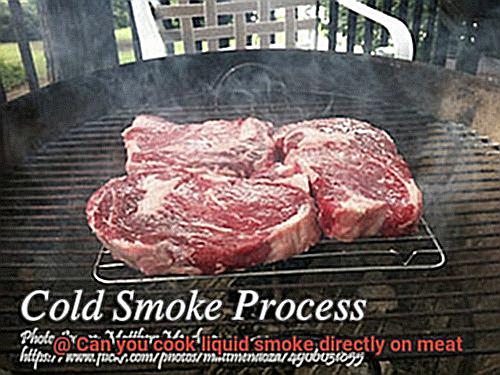
One of the simplest ways to use liquid smoke is by adding it to a base of tomato sauce or barbecue sauce. This will give your sauce a smoky flavor without the need for actual smoking. However, be careful not to use too much, as it can quickly overwhelm other flavors in the sauce.
Mix with Spices and Seasonings
Mixing liquid smoke with other spices and seasonings is another great option for creating a dry rub for your meat. Apply the rub directly onto the meat before grilling or smoking, and you’ll get that delicious smoky flavor you’re craving.
Use as a Marinade
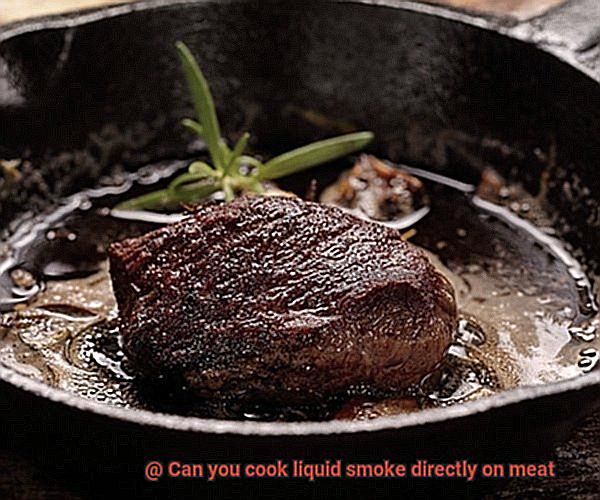
If you want to infuse your meat with a subtle smoky flavor, mix liquid smoke with oil, vinegar, herbs, and spices to create a flavorful marinade. Coat the meat in the marinade and let it sit in the fridge for several hours or even overnight for maximum flavor.
Remember It’s Not a Substitute
While liquid smoke adds a smoky flavor to your meat, it’s important to remember that it won’t provide the same depth of flavor as smoking over wood or charcoal. However, it’s still an excellent option for those who don’t have access to a smoker or don’t have the time to smoke their meat.
Tips for Using Liquid Smoke Sparingly
Liquid smoke is a popular ingredient for those who crave a smoky flavor in their grilled and barbecued dishes. However, using it sparingly is essential to avoid overpowering the natural taste of the meat. Here are some tips to help you achieve the perfect balance of smoky goodness without going overboard.
Start small and gradually increase the amount of liquid smoke used until you reach your desired flavor. This is particularly important if you’re using liquid smoke for the first time, as it’s easy to add too much too quickly. Remember that even a few drops or a teaspoon of liquid smoke can go a long way.
If you’re looking to dilute the strong flavor of liquid smoke, mix it with other ingredients like olive oil, vinegar, or honey. This will help balance out the smokiness and prevent it from being too overpowering. You can also use a spray bottle to apply the liquid smoke, which offers better control over the amount used.
When applying liquid smoke directly onto meat, brush it on lightly with a light hand to ensure even distribution without overwhelming the meat. Another way to achieve a smoky flavor without using too much liquid smoke is to combine it with natural smoking methods like charcoal or wood chips. This will enhance the smoky flavor while reducing the amount of liquid smoke needed.
Benefits of Adding Liquid Smoke to Dishes
Liquid smoke is made by capturing the smoke from burning wood chips or sawdust and converting it into a liquid form. It’s commonly used in marinades, sauces, and rubs for meat, poultry, and fish, but can also be added directly to the meat for a smoky flavor.
Adding liquid smoke to your dishes provides several benefits. Firstly, it gives that smoky flavor without the need for outdoor grilling. This is perfect for those who live in apartments or areas where grilling is not possible. You can add it to dishes cooked in the oven, on the stovetop, or even in a slow cooker to give them that delicious smoky taste.
But wait, there’s more. Liquid smoke can also help to tenderize meat by breaking down its proteins. This means even tough cuts of meat such as brisket or pork shoulder will come out juicy and tender when cooked with liquid smoke. And if that wasn’t enough, liquid smoke also acts as a preservative due to its antimicrobial properties. It can help prevent the growth of bacteria and other microorganisms that can spoil food, making it ideal for preserving meats and other foods stored for an extended period.
To use liquid smoke, start small and gradually increase the amount used. You can dilute it with other ingredients like olive oil or vinegar and use a spray bottle for better control. Or if you prefer, you can combine it with natural smoking methods like charcoal or wood chips.
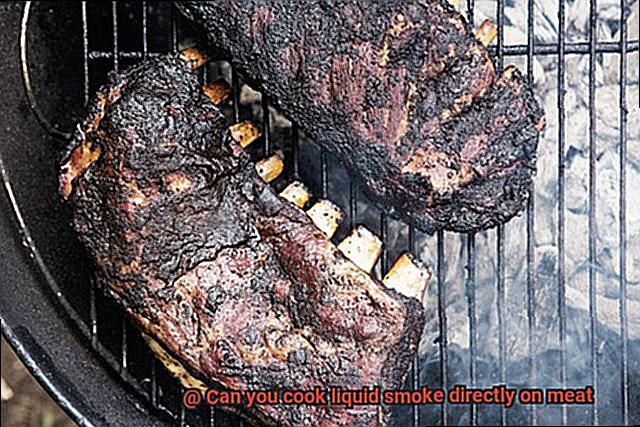
Alternatives to Using Liquid Smoke
As an expert in this field, I’ve done the research and found some great alternatives to using liquid smoke.
First up, we have smoked salts and seasonings. These products are made by smoking sea salt or other spices over wood chips, giving them a natural smoky flavor that can be added directly to meat before cooking. Not only do they add a delicious smoky taste, but they also bring a unique texture and color to your dish. Smoked paprika is another excellent option that can add both color and flavor to your meat.
For those who desire a more traditional method, actual wood chips or chunks for smoking are the perfect alternative. This method is often used by professional pitmasters and involves placing soaked wood chips or chunks on hot coals or in a smoker box on a gas grill. The meat then absorbs the smoke from the wood as it cooks. While it may take longer than using liquid smoke, the result is worth it.
If you don’t have access to a smoker or grill, stovetop smoking is another option. This method involves placing wood chips in a stovetop smoker or DIY foil packet and heating them until they begin to smoke. The meat is then placed on a rack above the wood chips and covered with a lid to trap in the smoke. This method allows you to achieve that smoky flavor without ever leaving your kitchen.
VcMXqFd-5Fk” >
Conclusion
To sum it up, liquid smoke is a game-changer for meat enthusiasts who crave that smoky taste. This ingredient has been around for more than a century and comes in liquid form, providing a concentrated smoky flavor that can be applied directly to meat as a marinade, rub, or brushed on during cooking. However, it’s crucial to use it sparingly since too much can overpower the dish’s taste and even lead to health issues.
Although liquid smoke can be used directly on meat, there are some things to keep in mind for optimal results. Proper seasoning of the meat before applying liquid smoke is vital, and using it sparingly will ensure that the dish doesn’t become too smoky.
Using liquid smoke directly on meat poses a risk of forming harmful chemicals like polycyclic aromatic hydrocarbons (PAHs), which can cause cancer and other health problems. Nevertheless, remember that while liquid smoke may not provide the same level of smokiness as traditional smoking methods, it still adds an incredible depth of flavor to your meat.

